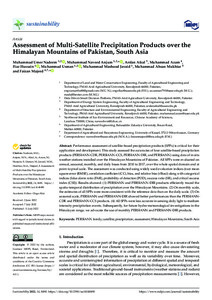| dc.date.accessioned | 2022-08-22T12:40:58Z | |
| dc.date.available | 2022-08-22T12:40:58Z | |
| dc.date.issued | 2022-07-11 | |
| dc.identifier | doi:10.17170/kobra-202208226715 | |
| dc.identifier.uri | http://hdl.handle.net/123456789/14087 | |
| dc.description.sponsorship | Gefördert durch den Publikationsfonds der Universität Kassel | ger |
| dc.language.iso | eng | |
| dc.rights | Namensnennung 4.0 International | * |
| dc.rights.uri | http://creativecommons.org/licenses/by/4.0/ | * |
| dc.subject | PERSIANN family | eng |
| dc.subject | satellite | eng |
| dc.subject | precipitation | eng |
| dc.subject | assessment | eng |
| dc.subject | Himalayan Mountains | eng |
| dc.subject | South Asia | eng |
| dc.subject.ddc | 630 | |
| dc.subject.ddc | 620 | |
| dc.title | Assessment of Multi-Satellite Precipitation Products over the Himalayan Mountains of Pakistan, South Asia | eng |
| dc.type | Aufsatz | |
| dcterms.abstract | Performance assessment of satellite-based precipitation products (SPPs) is critical for their application and development. This study assessed the accuracies of four satellite-based precipitation products (PERSIANN-CDR, PERSIANN-CCS, PERSIANN-DIR, and PERSIANN) using data of in situ weather stations installed over the Himalayan Mountains of Pakistan. All SPPs were evaluated on annual, seasonal, monthly, and daily bases from 2010 to 2017, over the whole spatial domain and at point-to-pixel scale. The assessment was conducted using widely used evaluation indices (root mean square error (RMSE), correlation coefficient (CC), bias, and relative bias (rBias)) along with categorical indices (false alarm ratio (FAR), probability of detection (POD), success ratio (SR), and critical success index (CSI)). Results showed: (1) PERSIANN and PERSIANN-DIR products efficiently traced the spatio-temporal distribution of precipitation over the Himalayan Mountains. (2) On monthly scale, the estimates of all SPPs were more consistent with the reference data than on the daily scale. (3) On seasonal scale, PERSIANN and PERSIANN-DIR showed better performances than the PERSIANN-CDR and PERSIANN-CCS products. (4) All SPPs were less accurate in sensing daily light to medium intensity precipitation events. Subsequently, for future hydro-meteorological investigations in the Himalayan range, we advocate the use of monthly PERSIANN and PERSIANN-DIR products. | eng |
| dcterms.accessRights | open access | |
| dcterms.creator | Nadeem, Muhammad Umer | |
| dcterms.creator | Anjum, Muhammad Naveed | |
| dcterms.creator | Afzal, Arslan | |
| dcterms.creator | Azam, Muhammad | |
| dcterms.creator | Hussain, Fiaz | |
| dcterms.creator | Usman, Muhammad | |
| dcterms.creator | Javaid, Muhammad Mashood | |
| dcterms.creator | Mukhtar, Muhammad Ahsan | |
| dcterms.creator | Majeed, Faizan | |
| dc.relation.doi | doi:10.3390/su14148490 | |
| dc.subject.swd | Pakistan | ger |
| dc.subject.swd | Himalaya | ger |
| dc.subject.swd | Niederschlagsmenge | ger |
| dc.subject.swd | Meteorologische Station | ger |
| dc.subject.swd | Klima | ger |
| dc.subject.swd | Messgerät | ger |
| dc.type.version | publishedVersion | |
| dcterms.source.identifier | eissn:2071-1050 | |
| dcterms.source.issue | Issue 14 | |
| dcterms.source.journal | Sustainability | eng |
| dcterms.source.volume | Volume 14 | |
| kup.iskup | false | |
| dcterms.source.articlenumber | 8490 | |


